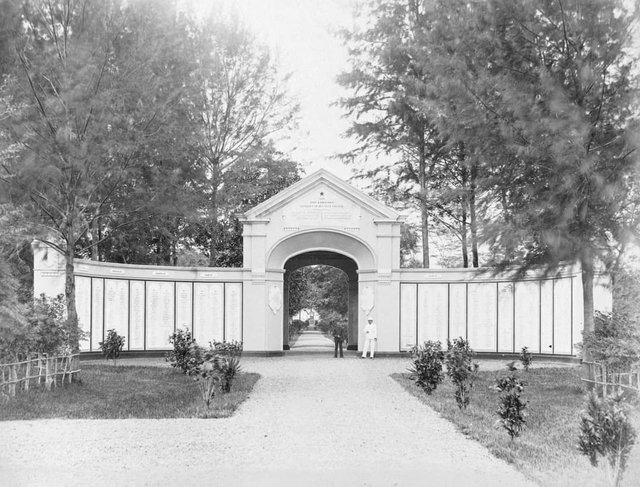The first KNIL victims of the Aceh War were buried close to the mouth of the Kroëng Aceh . (With the exception of the remains of Major General Köhler, which was initially buried in Batavia) But with the definitive conquest of Banda Aceh in 1874, it was decided to set up a permanent military cemetery there. A piece of land was chosen as location, south-west of the craton, where some very old sultan's tombs were already located. For example, a sultan's son was buried there by the name of Phoë-teu-tjoet. Phoe-teu means master, lord or prince, and tjoet means young or small. In time the name changed to Peutjoet.
Thousands of soldiers have been buried at Peutjoet over the years. It is no longer possible to ascertain how many these have been. It is estimated in the Aceh war that around 2,000 soldiers died or died from wounds received and around 10,000 soldiers died from illnesses and accidents. Although military cemeteries have been set up in several places , the majority will be buried at Peutjoet, all the more if it is taken into account that the battle took place in or in the immediate vicinity of Kotta Radja for roughly the first twenty years. In addition to soldiers, civilians are also buried at Peutjoet. Often it concerned women and children of soldiers.
Peutjoet's monumental entrance gate with its marble plaques was put into use in 1893 . It is worth noting that it was not set up by the government, but by private initiative. In 1887 a number of high-ranking officers set up a committee that appealed to all officers and subs of the navy, officers of the Dutch army, Indies officials and the entire Indian army, to contribute to creation of a memorial to the fallen at Peutjoet cemetery.
It is important to note that it was never the intention of the initiators to erect a monument for all deceased soldiers, but only for those who died or died from the consequences of wounds received. This is stated in the call as follows: […]  to erect a memorial pillar or temple (mausoleum) in the cemetery, on or in which the names of all, regardless of rank, rank, grade or country, will be chiselled, in the Aceh war for the Netherlands died or by their wounds obtained in the war ”. There was literally and figuratively no room for soldiers who died as a result of illness and accidents - at least on the marble memorial plaques. More than 1,400 names had already been carved into the marble when it was founded.
to erect a memorial pillar or temple (mausoleum) in the cemetery, on or in which the names of all, regardless of rank, rank, grade or country, will be chiselled, in the Aceh war for the Netherlands died or by their wounds obtained in the war ”. There was literally and figuratively no room for soldiers who died as a result of illness and accidents - at least on the marble memorial plaques. More than 1,400 names had already been carved into the marble when it was founded.
Another special feature of Peutjoet is that it is not a uniform necropolis, like contemporary military cemeteries, but a colorful variety of very simple crosses to almost un-Dutch grave monuments. Some of the graves of famous officers even had bronze statues, but unfortunately none of these survived the Japanese occupation. Over the decades, Peutjoet would grow into the most monumental war cemetery in Dutch colonial history. No other field has more Knight's Military Order of William buried than Peutjoet. They testify not only to their courage in a long and hard war, but also to the bravery and the sense of independence of their Acehnese opponents.
After the independence of Indonesia in 1949, it was strangely determined that Peutjoet would not come under the management of the Dutch War Graves Foundation, but under the management of the Indonesian government. Due to ongoing political unrest in Aceh, little or no attention was paid to Peutjut in the first years after Indonesia's independence. It was not until 1970 that the tide turned, mainly thanks to the efforts of a former KNIL soldier, Colonel Brendgen. The Peutjut Fund Foundation, co-founded by him, has saved Peutjoet from destruction. The local government also paid more attention to Peutjoet and its great significance for the history of Aceh.

Just before the disastrous tsunami of December 26, 2004, Peutjoet was about 80 percent restored. The natural disaster left enormous marks on the cemetery: half of the graves were destroyed or badly damaged. The tsunami had a height of about four meters at the gate. After the tsunami, the entire field of honor was covered with a layer of sea silt and mud of 20 to 40 cm thick. Most of the 2.5 meter high walls around the cemetery had been removed. Dozens of car wrecks and mountains of wreckage and debris were found in the cemetery. In addition, some sixty bodies of people drowned in the tsunami were found during the removal of the rubble and wrecks.
In close consultation with the Aceh Governorate, the Peutjut Fund Foundation has started the repair, restoration and renovation of Peutjoet. Much of this work has already been completed. Peutjoet is now on the monument list of Indonesia. However, the funding still comes from the Netherlands. The future will tell whether Peutjoet can be preserved for posterity.